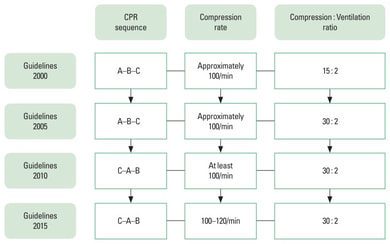 CPR guidelines recommend 30 chest compressions followed by 2 breaths as one cycle. The reason for this specific number is based on a lot of factors, including physiological considerations and research conducted on CPR guidelines throughout the last 75 years. The recommendation for 30 compressions in each cycle has evolved over time based on research and feedback from medical professionals (which is still ongoing). For example, the American Heart Association first recommended 15 compressions followed by 2 breaths in 1966, and later in the 1970s changed it to 5 compressions followed by 1 breath for 2 rescuers. The current recommendation of 30 compressions followed by 2 breaths was adopted in 2005 and has remained the standard since then, although the rate of compressions has changed to its current 100-120 cpm (compressions per minute). Compressions squeeze the heart and pump oxygenated blood throughout the body's organs and (crucially) the brain. Proper compression depth and rate is important to adequately squeeze the heart so that blood actually pumps around the body. But why group them into sets of 30?
Your blood vessels (arteries, veins, and capillaries) are not rigid like a hose or PVC tubing, they're more flexible and elastic like one of those balloons they make balloon animals out of! When a heart stops beating, the pressure in those vessels begins to drop and eventually gravity becomes the main force of moving blood around (leading to something called dependent lividity).
That means it takes a few compressions to get a person in cardiac arrest's blood pressure up enough to where blood starts to flow around the body, depending on how long it has been since they went into cardiac arrest. 30 compressions at a rate of 100-120 cpm with a less than 10 second gap between each cycle for breaths would mean a person gets somewhere between 60 and 90 compressions each minute, which is the range of a normal resting heart rate. 1 Cycle: 30 compressions (15-18 seconds) + 2 breaths (5-10 seconds) = 20-28 seconds As anyone who has done CPR knows, it can take a few compressions to get into the feel of the right depth and rate, and keeping it going is exhausting! 30 compressions helps us keep their blood pressure up without tiring responders out too quickly. If there are lots of responders around, they can rotate and keep up high-quality CPR going for much longer than one person can alone! Bottom line: the earlier we can start high-quality CPR the better and if more people are trained, we can keep that high-quality CPR going for longer. Get trained today!
0 Comments
Your comment will be posted after it is approved.
Leave a Reply. |
AuthorsOur coaches are working hard gaining experience and putting together resources to help YOU!
NOTE: All of our College Success tips work for ANY level of school!
Archives
July 2024
Categories
All
|

 RSS Feed
RSS Feed